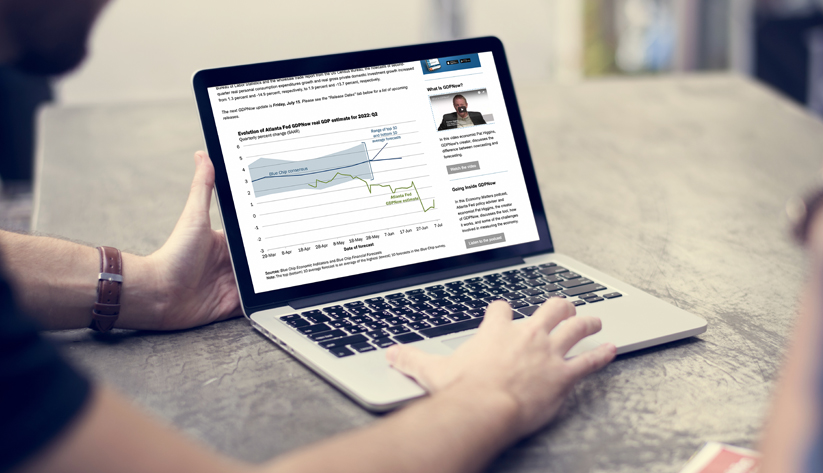
Nota del editor: Este artículo también está disponible en español.
The Atlanta Fed's GDPNow has become a touchstone this summer in the financial media's quest to divine the chances of a recession, and its extent if one arrives, as the Federal Reserve raises the federal funds rate to curb inflation.
Reports about GDPNow's estimates for gross domestic product (GDP) have run the gamut, including one from a podcaster in early July with this headline: "The Atlanta Fed Just Leaked July 28th's GDP Report." The Wall Street Journal opted for a less sensational approach: "Cooling Consumer Spending Points to Further Economic Slowdown."
What these reports and others have in common is a recognition of the respect for, and historic accuracy of, a tool designed by economists in the Research Department at the Federal Reserve Bank of Atlanta. The tool's purpose is to provide "a running estimate of real GDP growth based on available economic data for the current measured quarter." GDPNow has provided an absolute forecast error of just 0.5 percent for the first 5½ years the tool was available online, the period leading up to the COVID-19 pandemic.
What GDPNow is and is not
Although GDPNow has been less accurate since the pandemic rocked the macroeconomy, economists have tweaked the model two times since. (You can hear Pat Higgins, the Atlanta Fed economist who developed GDPNow, discuss the tool and how it performed during the pandemic in this episode of the Economy Matters podcast.) These two modifications are among only four that have been made since the model, devised in 2011, became available online in 2014, according to a report about these modifications on the Atlanta Fed website. Meanwhile, the accuracy of professional forecasters in general has also deteriorated during the pandemic, as this recent Macroblog entry noted. Unlike many professional forecasts, results published on GDPNow are derived purely from mathematical calculations. No subjective adjustments are made once the model is set.
GDPNow may be easiest to understand if we start with what it is not. It's not the Bank's official forecast of GDP, the tally of finished goods and services produced in the nation. And it's not endorsed by the Atlanta Fed, its president, the Federal Reserve System, or the Federal Open Market Committee.
Instead, GDPNow is a nowcast, an aggregation of many economic indicators. These data are entered into a mathematical model to calculate a GDP estimate at that point in time. As time passes and more reports are issued, more economic indicators are fed into the model. These reports come from such entities as the US Bureau of Labor Statistics, the US Census Bureau, the Institute for Supply Management, and the US Department of the Treasury. The accumulated data—some of which are also behind the Commerce Department's official GDP estimate—contribute to the historic accuracy of GDPNow's calculations in relation to the GDP reports that the US Bureau of Economic Analysis (BEA) releases.
The following description on the GDPNow's web page addresses the relation between estimates provided by GDPNow and the BEA's GDP report:
The growth rate of real gross domestic product (GDP) is a key indicator of economic activity, but the official estimate is released with a delay. Our GDPNow forecasting model provides a "nowcast" of the official estimate prior to its release by estimating GDP growth using a methodology similar to the one used by the US Bureau of Economic Analysis.
The advent of COVID-19's effect on the economy is addressed in this statement in the description of GDPNow:
In particular, it does not capture the impact of COVID-19 and social mobility beyond their impact on GDP source data and relevant economic reports that have already been released. It does not anticipate their impact on forthcoming economic reports beyond the standard internal dynamics of the model.
The Atlanta Fed's efforts to be as transparent as possible are evident in disclosures published on the website. The GDPNow's home page provides links to pages that enable readers to go behind the curtain to view how the data are compiled and results derived. These pages include recent forecasts; spreadsheets that offer "underlying source data, forecasts, and model parameters;" and an archive of commentaries from GDPNow estimates. The methodology is described in a 2014 paper by Patrick Higgins, a policy adviser and economist on the macroeconomics and monetary policy team in the Atlanta Fed's Research Department. Higgins originally developed the "nowcast" to be one of many inputs consulted in the briefing process leading up to Federal Open Market Committee meetings.
Dipping into negative territory
The many observers who were surprised by the negative forecast of GDPNow released on July 1 were presented with the following description of factors that contributed to the drop of the nowcast further into negative territory, to -2.1 percent from -1.0 the previous day (emphasis is original):
The GDPNow model estimate for real GDP growth (seasonally adjusted annual rate) in the second quarter of 2022 is -2.1 percent on July 1, down from -1.0 percent on June 30. After this morning's Manufacturing ISM Report On Business from the Institute for Supply Management and the construction report from the US Census Bureau, the nowcasts of second-quarter real personal consumption expenditures growth and real gross private domestic investment growth decreased from 1.7 percent and -13.2 percent, respectively, to 0.8 percent and -15.2 percent, respectively.
The ISM and Census Bureau reports reflect changes in market conditions that may influence GDP. Federal policy shifts also can influence inputs into the GDPNow model. One example that's recent and continuing involves US trade restrictions imposed on Russia and Belarus following Russia's invasion of Ukraine. The Commerce Department issued a ruling in February this year intended to withhold US exports that could be used in Russia's oil extraction sector. The White House followed on March 8 with its ban on the import of Russian oil, liquefied natural gas, and coal.
Vigorous changes in the US economy of late have given the GDPNow model the opportunity to show its ability to quickly absorb new information and produce an updated forecast.
At the start of summer 2022, the model's forecasts changed materially as new figures for personal consumption expenditures and retail sales were plugged into the equation. This is not surprising given the large expenditure shares each of these components represent in the GDP.
In addition, the model had to accommodate an input that caused significant changes to the forecast–inventory investment. Businesses added to their real inventory at record rates in the final quarter of 2021 and the first quarter of 2022. The increases totaled an annualized rate of $190 billion in each of the two quarters as measured in 2012 dollars.
The figures appeared in late April in the GDPNow forecast, which expected that second-quarter real inventory accumulation would fall short of the first quarter total by $56 billion. The model now estimates the shortfall was $123 billion. Consequently, it estimates inventory investment subtracted 2½ percentage points off second-quarter GDP growth. The model estimates real final sales, which omits inventory investment from the GDP calculation, grew 1.3 percent last quarter.
Pat Higgins, a policy adviser and economist on the macroeconomics and monetary policy team in the Atlanta Fed's Research Department, addressed the complexity of the relation between inventory and consumer spending in his June 29 presentation to a group of economists. A description on one slide observes: "Even though consumer spending comprises nearly 70 percent of GDP, the standard deviation of its contribution to GDP growth from 2000 to 2019 was lower than either inventory or total investment. That has changed during the pandemic: consumer spending has been a more volatile contribution to quarterly growth than investment even after discarding the first three quarters, which had sectors of the economy virtually closing then reopening. That is one reason why it has become more difficult to "nowcast" GDP growth during the pandemic."
Market conditions since the embargo have been making headlines for months. The $1.34 billion of refined petroleum products the United States imported from Russia in April fell to $0 imported in May, as trade restrictions blocked products categorized as mineral fuels, lubricants, and related materials, according to information from the Census Bureau.
The collapse in the import of Russian petrol products coincided with price hikes at the gas pump. These increases appear in declines in the category of personal consumption expenditures (PCE), which contributed to the recent decline in the GDPNow forecast. PCE fell from 4.7 percent on May 27 to 1.7 percent on June 30, in terms of forecasted annualized growth rate. The GDPNow forecast fell during the same period, from 1.9 to -1.0.
The Atlanta Fed's GDPNow model and the BEA's GDP forecast place high value on PCE, as well as on categories in goods and services that include construction spending, housing starts, and prices of new and resale dwellings. Components that have medium correspondence to the forecast include foreign trade and employment by state and local governments. These components and others are the object of constant attention as the GDPNow continually evolves to meet conditions the future will bring. Higgins posed just such a question at the conclusion of a June 29 presentation to economists: "Open question: Will it continue to be more difficult to nowcast GDP than it was prior to the pandemic?"
Download the Atlanta Fed's research app, EconomyNow, to stay up to date on GDPNow and get access to other useful economic data from the Atlanta Fed.




